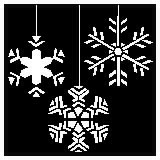|
Mathematics is much more than finding sums, differences, products, and quotients. Mathematics is a way of looking at the world. As a mathematician, you view the world looking for regularity and order or the lack of order and regularity.
Point Symmetry
We are surrounded by all types of symmetry, a type of regularity and order--in nature, in architecture, in art and much more. 
The symmetry that is the least talked about is point symmetry even though it can be spotted everywhere in the world around you, however. Point symmetry is a special subset of rotational symmetry. In other words, any figure that has point symmetry has rotational symmetry. However, any figure with rotational symmetry does not necessarily have point symmetry.
A figure that can be turned about a point 180 degrees and land on an image of itself is said to have point symmetry and rotational symmetry of order 2. Another way to check for point symmetry is to turn the image upside down and see if it looks exactly the same! The picture of the basketball has point symmetry. It has rotational symmetry of order 2 and magnitude of 180 degrees so it also has point symmetry.
When you look at the examples of point symmetry below find the order of rotation for the figures with and the figures without point symmetry to see if you can find a pattern.
|
These objects have point symmetry:
|
|
These objects do not have point symmetry: |
 |
 |
 |
 |
|
 |
 |
For more information and activities about Point Symmetry, visit these pages.
[Pattern Blocks] [Cards] [Activities] [Extensions] [Challenge] [Symmetry Home Page]
These symmetry pages have been brought to you by Nancy Powell, a TeachNet Web Mentor from Bloomington High School, Bloomington, IL.
|